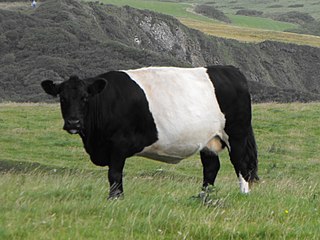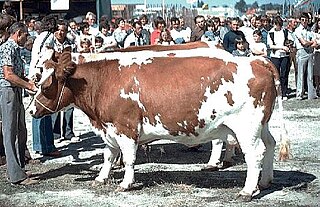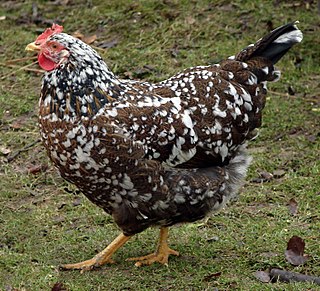
The Lakenvelder is a Dutch and German breed of dairy cattle. It is reported from the Netherlands and Belgium, but may be extinct in Germany.

The Dairy Shorthorn is a British breed of dairy cattle. It derives from the Shorthorn cattle of Tees-side, in the North Riding of Yorkshire and in Northumbria in north-eastern England. The Shorthorn was for this reason at first known as the Durham or Teeswater.

The Belted Galloway is a traditional Scottish breed of beef cattle. It derives from the Galloway cattle of the Galloway region of south-western Scotland, and was established as a separate breed in 1921. It is adapted to living on the poor upland pastures and windswept moorlands of the region. The exact origin of the breed is unclear, although the white belt for which they are named, and which distinguishes the breed from black Galloway cattle, is often surmised to be the result of cross-breeding with the similarly-coloured Dutch Lakenvelder breed.

The Randall Lineback or Randall is an American breed of cattle. It originated in Bennington County, Vermont, and is critically endangered.
The Buelingo is a modern American composite breed of belted beef cattle, created in North Dakota, in the United States. It is named for Russ Bueling, who owned the foundation stock in the early 1970s.

The Old Gloucester or Gloucester is a traditional British breed of cattle originating in Gloucestershire and surrounding areas in the West Country of England. It was originally a triple-purpose breed, reared for milk, for beef and for draught use; it is now a dual-purpose animal. It is an endangered breed, and its conservation status is listed as "priority" by the Rare Breeds Survival Trust.

The Japanese Brown is a breed of small Japanese beef cattle. It is one of six native Japanese cattle breeds, and one of the four Japanese breeds known as wagyū, the others being the Japanese Black, the Japanese Polled and the Japanese Shorthorn. All wagyū cattle derive from cross-breeding in the early twentieth century of native Japanese cattle with imported stock, mostly from Europe. In the case of the Japanese Brown, the principal foreign influence was from the Korean Hanwoo and Swiss Simmental breeds.

The Armoricaine or Armorican is an endangered French breed of domestic cattle. It originated in Brittany in the nineteenth century. It has a red coat with white markings, and has short horns.

The Pie Rouge des Plaines is a modern French breed of dairy cattle. It was created in about 1970 by cross-breeding the traditional Armorican cattle of Brittany, in north-western France, with red-pied cattle of the Dutch Meuse-Rhine-Yssel and German Deutsche Rotbunte breeds.

The Fjäll is a traditional Swedish breed of polled mountain cattle. It was threatened with extinction in the 1970s and 1980s, but recovered after a breed association was formed in 1995, partly thanks to stocks of frozen semen. Microsatellite analysis has shown it to be closely related to the endangered Bohuskulla breed.

The Hereford Hog or Hereford is an American breed of domestic pig. It is named for its color and pattern, which is similar to that of the Hereford breed of cattle: red with a white face.

The Swedish Flower Hen, Swedish: Skånsk Blommehöna, is an endangered traditional Swedish breed of domestic chicken. It is one of eleven traditional chicken breeds in Sweden.

The Estonian Red is an Estonian breed of dairy cattle. It was developed in the second half of the nineteenth century from cross-breeding of local cattle with imported stock of the Angeln, Danish Red and North Slesvig Red breeds. The coat is red, but sometimes it varies from red-white to brown and rarely black.

The Swedish Red-and-White, Swedish: Svensk Röd och Vit Boskap, frequently abbreviated to SRB, is a Swedish breed of dairy cattle. It was created in the 1920s by crossing the Swedish Red Pied and Swedish Ayrshire breeds.
The Swedish Red Pied, Swedish: Rödbrokig Svensk Boskap, frequently abbreviated to RSB, was a Swedish breed of dairy cattle. It is now considered extinct. It was merged in the 1920s with the Swedish Ayrshire breed to create the Swedish Red-and-White, which is one of the principal dairy breeds of Sweden.

The Swedish Polled, Swedish: Svensk Kullig Boskap, often abbreviated to SKB, is a Swedish breed of domestic cattle. It was created in 1937 from two different Swedish cattle breeds, the Swedish Red Polled and the Fjäll. Breeders did not accept the new classification, and continued to maintain separate bloodlines as before. Of the two constituent breeds, the Swedish Red Polled received official recognition in 2004, while the Fjäll has divided into two sub-breeds, the Fjällnära Boskap and the Svensk Fjällras.

The Väneko is an endangered Swedish breed of dairy cattle. It is named for the village of Väne-Ryr in the landskap of Västergötland, in western Sweden. It is a traditional domestic Swedish breed, and derives from a group of cattle discovered in the 1990s, at a time when all traditional Swedish horned cattle were thought to have disappeared.
The Bohuskulla is an endangered Swedish breed of hornless mountain cattle. It originates from the area of the Kynnefjäll plateau in northern Bohuslän and Dalsland, in western Sweden. It is a traditional domestic Swedish breed, and derives from a group of cattle discovered in the 1990s in Skepplanda, in Västergötland, close to the border with Bohuslän. Microsatellite analysis has shown it to be closely related to the Fjällko mountain cattle of Sweden.

The Ankole is a breed or group of breeds of African cattle, belonging to the broad Sanga cattle grouping of African breeds. It was probably introduced to Uganda between five and seven hundred years ago by nomadic pastoralists from more northerly parts of the continent. It is distributed in much of eastern and central Africa, particularly in Uganda, the Democratic Republic of the Congo, Rwanda, Burundi and parts of Tanzania. There are at least five distinct regional strains, some of which may be reported as breeds in their own right. These include:

The Red Brangus is an American breed of hybrid beef cattle, with both taurine and indicine genetic heritage. Development began in Texas in the 1940s. It is a colour variant of the Brangus, a hybrid of American Angus and Brahman cattle, and differs from it only in colour. There are two herd-books, one international and one American. For international registration the animal must be of 5/8 Angus and 3/8 Brahman descent; in the United States, it may be any mix of the two breeds, but registration is conditional on inspection.

















